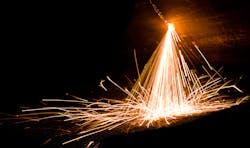Here’s How to Improve Arc-Flash Safety in the Workplace
An arc flash occurs due to a phase-to-ground or phase-to-phase short circuit. The extreme heat, light, and pressure blasts associated with these events make it necessary to take precautions when engaging in activities that may involve arc flashes.
These flashes can happen whenever people work with electrified equipment. If your workplace has CNC machines, CNC plasma cutters are among the most common pieces of equipment associated with arc flashes. Here are some proactive steps you can take to promote arc-flash safety at work.1. Wear the right clothing. Staying safe from arc flashes starts with wearing flame-resistant clothing. Burns are among the most common consequences of arc-flash accidents. A related issue is that arc flashes cause clothing to immediately ignite.
Smart apparel choices also extend to what not to wear. Such materials include rayon, nylon, polyester, and acetate. Even Category 0 personal protective equipment (PPE) requires people to don shirts and pants made from cotton or untreated fiber to reduce the risk of arc-flash complications. That’s because synthetic fabrics such as polyester may melt due to the associated heat.
Keeping a checklist posted near a CNC plasma cutter can be an actionable way to continually remind people about the clothing they must wear before using the machine. The same is true when training employees who are new to working with a CNC plasma cutter.2. Select face and respiratory protection. An arc flash can result in poisonous gases that hurt the lungs if inhaled. It’s also crucial for users to realize that CNC plasma cutters can cause hazardous fumes and gases even during typical operation.
Users should keep their heads out of the fumes created by cutting and gouging materials, plus use adequate ventilation and exhaust to keep the odors away from the breathing space. Besides taking those precautions, they should choose face shields and consider wearing respirators under them.
Although a respirator may not have an arc rating, it can help individuals stay safe from fumes if a worksite assessment shows they would face above-average exposure without one. However, the crucial thing to keep in mind is that people should use respirators only under a face shield or hood.3. Keep equipment well-maintained. Numerous things — ranging from load break switch faults to loose connections — can make arc-flash dangers more likely. Insufficient equipment maintenance can also elevate the risk.
However, switching from a reactive to preventive maintenance strategy is an excellent way to stay on top of faults that could elevate safety risks. Another advantage is that your CNC plasma cutter is more likely to retain its efficiency over time, boosting the overall return on investment.
Examples of proactive steps to take for CNC plasma cutter upkeep range from cleaning the torch body and leads to making the rails level and aligned. Creating and sticking to a comprehensive maintenance strategy supports safety and prolongs the machine’s lifespan.4. Maintain the proper boundaries. Setting and adhering to proper boundaries is another essential step to promoting arc-flash safety. The Arc Flash Boundary is the point at which a worker’s maximum exposure to flash energy is no more than 1.2 calories per centimeters squared. A treatable second-degree is the worst injury the person should sustain.
Then, the Limited Approach Boundary represents the closest an observer can stand during the equipment’s operation without wearing protective gear.
Finally, the Restricted Approach Boundary defines the point where only trained people wearing the proper equipment can cross due to the risk of electric shock.
Posting signage to designate the boundaries is a best practice for keeping people safe. That applies to people operating the machinery as well as bystanders.5. Choose eye protection. Arc flashes can damage an individual’s retina due to the ultraviolet light radiation accompanying them. Relatedly, people can suffer a condition called flash burn, which is inflammation of the cornea. It usually heals within a day or two without leaving a scar. However, delayed treatment could lead to an infection that causes permanent eye damage.
A 2018 investigation into a plasma arc cutter used at a steel manufacturer confirmed optical radiation levels of ultraviolet-C, ultraviolet-B, and visible light ranges were higher than safe levels for people without eye protection.
Also, the highest non-ionizing radiation occurred when workers used the plasma cutters without welding curtains. However, the curtains did not remove the optical radiation hazards to machine operators or employees in the vicinity.
Besides having workers wear appropriate protection for their eyes, the people involved in the investigation recommended installing signs to alert people to the optical radiation risk. Doing that keeps operators safe, as well as anyone else nearby.6. Use earplugs. Research shows that sound pressures accompanying arc flashes can exceed 140 decibels, which is the level that can cause mechanical damage to the eardrum. Ear damage is not one of the arc flash consequences that come to mind most often, but it’s something people must consider as they review safety precautions.
NFPA 70E, known as the Standard for Electrical Safety in the Workplace, stipulates that anyone within an arc-flash boundary must wear hearing protection. Besides checking that all workers have earplugs before operating a CNC plasma cutter, safety managers should also post signs to warn others of possible hearing damage associated with arc flashes.
Practice Safety Every Day
These tips emphasize that staying safe begins with the decisions people make before they ever operate CNC plasma cutters or other electrified equipment.
Business and operations officials should regularly consider how to strengthen the safety culture in their organizations by making certain machine operators and anyone else arc flashes could affect how to take the right precautions in all applicable situations.
Emily Newton is the Editor-in-Chief of Revolutionized, an online magazine exploring the latest industrial innovations.
About the Author
Emily Newton
Emily Newton is the Editor-in-Chief of Revolutionized, an online magazine exploring the latest industrial innovations.






